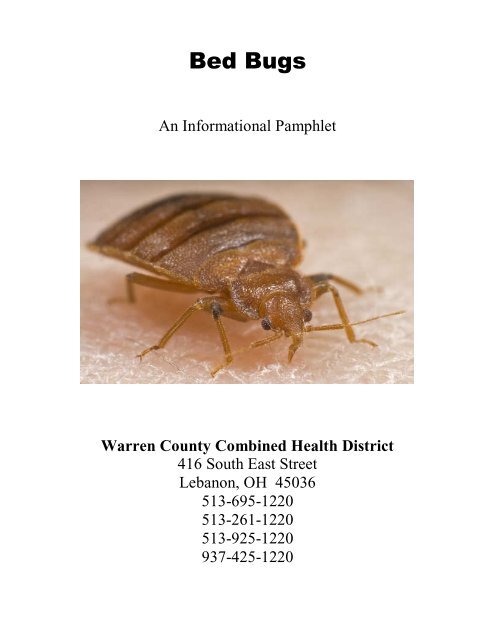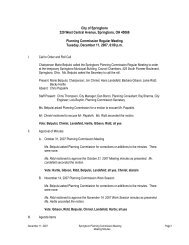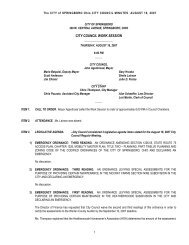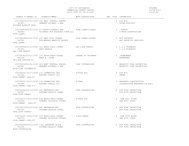Bed Bug Pamphlet - Springboro, Ohio
Bed Bug Pamphlet - Springboro, Ohio
Bed Bug Pamphlet - Springboro, Ohio
Create successful ePaper yourself
Turn your PDF publications into a flip-book with our unique Google optimized e-Paper software.
<strong>Bed</strong> <strong>Bug</strong>s<br />
An Informational <strong>Pamphlet</strong><br />
Warren County Combined Health District<br />
416 South East Street<br />
Lebanon, OH 45036<br />
513-695-1220<br />
513-261-1220<br />
513-925-1220<br />
937-425-1220
“Sleep Tight-Don’t Let the <strong>Bed</strong> <strong>Bug</strong>s Bite”<br />
We all grew up hearing the above phrase and not<br />
thinking much about the actual “bed bug” being<br />
referred to in it. <strong>Bed</strong> bugs are parasites whose<br />
preferential food is human blood. <strong>Bed</strong> bugs were<br />
once a common public health pest worldwide, but<br />
declined in incidence through the mid 20 th century,<br />
primarily due to the use of DDT. Recently however,<br />
bed bugs have undergone a dramatic resurgence and<br />
worldwide there are reports of increasing numbers of<br />
infestations. Locally we first began hearing about<br />
bed bugs being a problem in the urban areas, such as<br />
Cincinnati, <strong>Ohio</strong> several years ago. Then we began<br />
to receive complaints of bed bug problems in area<br />
motels. Now we receive several calls a week<br />
regarding bed bugs in apartments and homes. While<br />
many people associate bed bugs with unclean or<br />
unsanitary conditions, the problem may be found in<br />
the cleanest of homes, hotels, or other buildings.<br />
The purpose of this informational brochure is to<br />
provide the knowledge that property owners, tenants,<br />
landlords, and hotel managers will need should they<br />
learn that they have a bed bug problem in their home,<br />
apartment or hotel room. This brochure will provide<br />
information on the biology and health significance of<br />
bed bugs, offer guidance on inspecting for bed bugs,<br />
and provide information on how to safely and<br />
effectively manage an infested residence or hotel
oom. It will also discuss who is responsible for<br />
treatment of a bed bug problem in rental situations<br />
according to the Warren County Combined Health<br />
District Housing and Premise Maintenance Code.<br />
Biology of the <strong>Bed</strong> <strong>Bug</strong><br />
<strong>Bed</strong> bugs are small wingless insects that feed solely upon<br />
the blood of warm-blooded animals. They are sometimes<br />
mistaken for ticks or cockroaches. A mature bed bug is<br />
oval-bodied, brown to red-brown in color, wingless, and<br />
flattened top to bottom. Unfed bugs are ¼ to 3/8 inches<br />
long and the upper surface of the body has a crinkled<br />
appearance. A bed bug that has recently fed is engorged<br />
with blood, dull red in color, and the body is elongated and<br />
swollen. Eggs are white and are about 1/25 th of an inch in<br />
length. Newly hatched bed bugs are nearly colorless or<br />
straw-colored.<br />
Adult <strong>Bed</strong> <strong>Bug</strong><br />
<strong>Bed</strong> bugs require blood in order to reproduce and complete<br />
their life cycle. Female bed bugs deposit 3-8 eggs at a time<br />
with a total of 200-500 eggs being produced by a single<br />
female over her lifetime of 10 months. The eggs are<br />
deposited in clusters and fastened to cracks and crevices or<br />
rough surfaces near where the adult’s harborage areas with<br />
sticky cement-like substance. The eggs hatch in 4-12 days.
The newly hatched nymph is nearly colorless or strawcolored<br />
before feeding, and then turns red or purple in color<br />
after taking a blood meal. <strong>Bed</strong> bugs go through 5 nymphal<br />
stages before reaching maturity. This usually takes 35-48<br />
days. <strong>Bed</strong> bug nymphs can survive without feeding and<br />
adult bed bugs can survive for 6-7 months without a blood<br />
meal. They have been known to live in abandoned houses<br />
for at least a year.<br />
Habits<br />
<strong>Bed</strong> bugs are fast moving insects that are nocturnal<br />
blood-feeders. They feed mostly at night when their<br />
host, usually human, are asleep. After using their<br />
sharp beak to pierce the skin of a host, they inject a<br />
salivary fluid containing an anticoagulant that helps<br />
them obtain blood. Nymphs may become engorged
with blood within three minutes, whereas a fullgrown<br />
bed bug usually feeds for ten to fifteen<br />
minutes. They will then crawl away to a hiding place<br />
to digest the meal. <strong>Bed</strong> bugs do not have nests like<br />
ants or bees, but they do tend to congregate in<br />
habitual hiding places. They seem to prefer fabric,<br />
wood, and paper surfaces. They usually hide in close<br />
proximity to where their host sleeps, although they<br />
can travel fair distances to feed if necessary. <strong>Bed</strong><br />
bugs can initially be found in tufts, seams, and folds<br />
of mattresses, later spreading to crevices in the bed<br />
frame itself. In heavier infestations, they also may<br />
occupy hiding places farther from the bed, such as<br />
window and door frames, electrical boxes, floor<br />
cracks, baseboards, furniture, and under the tack-strip<br />
of wall-to-wall carpeting. <strong>Bed</strong> bugs often crawl<br />
upward to hide in pictures, wall hangings, drapery<br />
pleats, loosened wallpaper, cracks in plaster, and in<br />
ceiling moldings.<br />
Evidence of <strong>Bed</strong> bugs<br />
on mattress.
<strong>Bed</strong> bugs hiding in mattress seam.<br />
<strong>Bed</strong> bugs in<br />
<strong>Bed</strong> bugs in carpeting.
Public Health Significance of <strong>Bed</strong> <strong>Bug</strong>s<br />
While at least 27 agents of human disease have been<br />
found in bed bugs, including viruses, bacteria,<br />
protozoa, and parasitic worms, there is no evidence<br />
that bed bugs have ever been involved in the<br />
transmission (via a bite or from infected feces) of any<br />
disease agent, including hepatitis B virus and HIV,<br />
the virus that causes AIDS. The actual bite of the<br />
bed bug is painless. The amount of blood loss due to<br />
bed bug feeding typically does not adversely affect<br />
the host. Unlike flea bites, which occur mainly<br />
around the ankles, bed bugs feed on any bare skin<br />
exposed while sleeping (face, neck, shoulders, arms,<br />
hands, etc.) Skin reactions are commonly associated<br />
with bed bug bites, which results from the saliva<br />
injected during feeding. Usually, if there is any<br />
infection, it is a result of the host scratching the bite<br />
area and infecting the wound. Common allergic<br />
reactions include the development of large welts,<br />
often larger than 1 cm, which are accompanied by<br />
itching and inflammation. These welts usually<br />
subside to red spots but can last for several days.<br />
Blister-like eruptions have been reported in<br />
association with multiple bed bug bites and<br />
anaphylaxis may occur in patients with severe<br />
allergies. So, while bed bugs have never been proven<br />
to biologically transmit any human pathogen, we<br />
health officials are concerned with infestations due to<br />
the possibility of secondary infections.
Inspecting for <strong>Bed</strong> <strong>Bug</strong>s<br />
When bed bugs are suspected, a thorough inspection should<br />
be undertaken in areas where people sleep or rest. If the<br />
suspected infestation is in a motel environment, then<br />
housekeeping staff should be interviewed as they are likely<br />
to have detailed knowledge about signs of an infestation.<br />
Because bed bugs can hide in virtually any crack and<br />
crevice, you should inspect any dark, isolated, and<br />
protected areas in the vicinity of the sleeping area. <strong>Bed</strong><br />
bugs prefer wood, paper, and fabric surfaces and these<br />
materials should receive special attention during the<br />
inspection process. The mattress should be the first site<br />
inspected and the seams, beading, under buttons, labels,<br />
and corner protectors should be examined closely. In a<br />
motel environment, the headboard is often attached to the<br />
wall. The headboard should be removed and inspected<br />
behind in this case. Tell-tale signs of a bed bug infestation<br />
can be recognized by blood stains from crushed bugs or by<br />
rusty spots of excrement on sheets and mattresses, bed<br />
clothes, and walls. Fecal spots, eggshells, and shed skins<br />
may be found in the vicinity of their hiding places.<br />
Sometimes, if the infestation is heavy, there is an offensive,<br />
sweet, musty odor from their scent glands may be detected<br />
when bed bug infestations are severe.<br />
The areas around the bed should be investigated next,<br />
including the bedside furniture. The drawers in dressers<br />
should be removed and examined. Other furniture in the<br />
room should be inspected as well as any electronic devices<br />
in the room, such as clock radios, stereo equipment, etc.<br />
You should also inspect books, electrical outlets, base<br />
board, loose wall paper, picture frames and wall mirrors.<br />
In the case of a motel or an apartment complex, the
inspection should extend to any adjoining rooms within 20<br />
feet of the sleeping area. While bed bugs can travel over<br />
100 feet in one night, they tend to live within 8 feet of<br />
where people sleep.<br />
Treatment and Control of <strong>Bed</strong> <strong>Bug</strong>s<br />
If bed bugs are found you should contact a licensed pest<br />
control professional, though this is not required by code.<br />
There are a number of effective over-the-counter chemicals<br />
available for the control of bed bugs. If you decide to use a<br />
pest control professional you should ask the pest control<br />
professional to provide you with a written integrated pest<br />
management plan that will detail the methods and<br />
insecticides to be used by the pest control operator and<br />
outline responsibilities of the owner, apartment<br />
management, the tenant, or the motel management.<br />
Control and elimination of bed bugs will require the use of<br />
insecticides applied in conjunction with non-chemical<br />
means of control. Non-chemical means of control can<br />
range from cleaning, vacuuming, doing laundry, placing<br />
mattresses in zippered mattress covers to removal and<br />
disposal of heavily infested mattresses and furniture. In<br />
Warren County, <strong>Ohio</strong> we require that in the case of a multifamily<br />
building where there are two or more apartments<br />
with a bed bug infestation, the owner or landlord is<br />
responsible for either bringing in the licensed pest control<br />
professional or for treating themselves both the apartments<br />
infested as well as any adjacent apartment within 20 feet of<br />
the infested apartments sleeping area. The tenants are<br />
responsible for cooperating with the apartment<br />
management regarding access to their apartments for<br />
pesticide application as well as any physical control
measures recommended by the pest control professional or<br />
the health department. These can and will include cleaning<br />
and vacuuming the apartment, enclosing mattresses in<br />
zippered mattress covers, treatment of mattresses with<br />
pesticides approved for that use, or disposing of mattresses<br />
and furniture. The Warren County Combined Health<br />
District will not mediate disputes between apartment<br />
tenants and their landlords. Owners or occupants of an<br />
infested apartment if it is the only apartment infested or a<br />
single family home are responsible for the treatment of<br />
their bed bug problem. The owner or occupant of an<br />
apartment or single-family home may choose to bring in a<br />
licensed pest control applicator, though this is not required<br />
either. While some over-the-counter pesticides can be<br />
effective against bed bugs, it is still recommended that you<br />
bring in the licensed pest control operator to treat for bed<br />
bugs. Owners and occupants of infested apartments or<br />
homes are urged to follow the specific directions on the<br />
label of the pesticide they have purchased and to use the<br />
pesticide safely. Never use pesticides approved for outdoor<br />
use inside the home.<br />
If you choose to dispose of your furniture or mattress, you<br />
must wrap the furniture or mattress in plastic sheeting and<br />
seal it with tape. If the items are not wrapped and tapesealed,<br />
most refuse haulers will not pick the item up. One<br />
of the ways that bed bugs are spread from home to home is<br />
people picking up furniture that has been set out for refuse<br />
pickup and reusing the furniture in their own home. By<br />
wrapping the furniture or mattress in plastic, hopefully the<br />
individual, who might have taken the item for reuse, will<br />
recognize there is a problem and leave it for the refuse<br />
hauler.
The most effective chemical control of bed bugs must be<br />
completed by a licensed pest control professional. Residual<br />
insecticides (usually pyrethroids) are applied as spot<br />
treatments to cracks and crevices where bed bugs are<br />
hiding. Increased penetration of the insecticide into cracks<br />
and crevices can be achieved if accumulated dirt and debris<br />
are first removed using a vacuum cleaner. Remember to<br />
dispose of the vacuum cleaner bag once you have used it<br />
for this purpose. Avoid using highly repellent formulations,<br />
which may cause bed bugs to scatter. Dust formulations<br />
may be used to treat wall voids and attics. Repeat<br />
insecticide applications if bed bugs are present two weeks<br />
after the initial treatment since it is difficult to find all the<br />
hiding places and hidden eggs may have hatched.<br />
Do not use any insecticide on a mattress unless the product<br />
label specifically mentions such use. Very few insecticides<br />
are labeled for use on mattresses. If you are using an<br />
appropriately labeled insecticide on a mattress, take<br />
measures to minimize the pesticide exposure to the<br />
occupants. Apply the insecticide as a light mist to the<br />
entire mattress, opening seams, tufts, and folds to allow the<br />
pesticide to penetrate these areas. Allow the treated surface<br />
to completely dry before use. Do not sleep directly on the<br />
treated mattress. Be sure that bed linens are in place or<br />
place the treated mattress inside a zippered mattress cover.<br />
Never treat mattresses of children or people who are ill.<br />
<strong>Bed</strong> linens should never be treated with an insecticide.<br />
Instead, they should be either dry-cleaned or washed in hot<br />
water and dried using the “hot” setting.<br />
If you have any questions regarding bed bugs or this informational<br />
brochure, please contact our Environmental Health Division at<br />
513-695-1220, 513-261-1220, 937-425-1220, or 513-925-1220.







